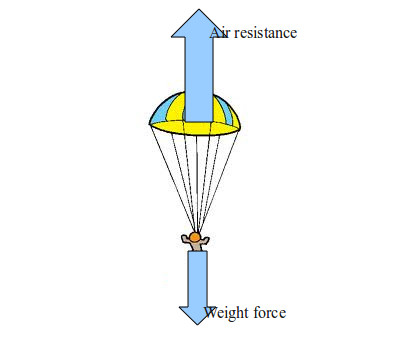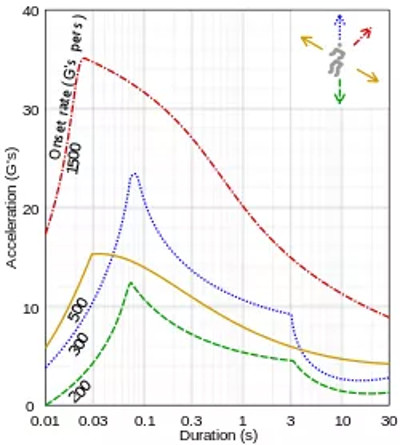Why can this man jump from 7,600 meters to the ground without parachutes
Luke Aikins - 42-year-old American, set a new world record by stepping out of the plane and falling freely from a height of about 7600m down a giant net 30 x 30 meters below without though. This is really crazy because only 1 mistake you will lose your life. So why does Luke Aikins do the impossible?
Short video back to Luke Aikins jumping from 7,600 meters
Let's learn some physics to see if there is a problem when jumping from that height?
In fact, it doesn't matter whether we jump from 7,600 meters or 4,600 meters. In both cases, our falling speed will be about 240km / h.
Why so? Read the explanation below:
If you remove the resistance, a ball falling 4 meters high will have twice the speed of the ball falling from a height of 1 meter.
So what is air resistance?
It is easy to understand that air resistance is the force against an object's movement. We can feel this clearly when reaching out the window of a moving vehicle (do not recommend doing this). This force depends on:
- Movement speed of the object in the air.
- Object size.
- Body shape.
- Density of air.
Since the air resistance depends on speed, the object in the initial resting state will have no air resistance.Gravity will pull things down and the falling speed will increase. When accelerating in the same direction as the speed, the object is falling at high speed. However, when an object falls, it will appear air resistance. This force also has a gradual increase in velocity until at some point, the resistance of the air will be equal to the gravitational force and the object will fall at a constant speed. This speed is called the final velocity.

Describe air resistance and gravity when a person parachutes.
The final velocity also depends on the shape and size of the object as well as its mass. For parachute jumpers, the final speed is usually from 193 km / h to 240 km / h.
Here is a simple test: Drop a coffee filter paper together with 2 coffee filters together.

Because coffee filter paper has the same shape and size, the only significant difference here is the volume. 2 composite filter papers will bear gravity twice as large when falling, thus achieving greater velocity.
So a skydiver who jumps from 7,600 meters will fall at the same speed as when jumping from a height of 4,600 meters.
But there's a big difference between 7,600 meters and 4,600 meters, which is the air density. At 7,600 meters, the air is very thin so the brain will not function properly. That's why climbers and parachutes often wear oxygen masks when they are very high above sea level.
So what role does the net play here?
Stopping a person or an object depends on the acceleration. Acceleration depends on the velocity change and the time to make this change. No matter what, the parachute's speed will always drop from 150 mph to 0 mph - the question is how long it will take. If human acceleration is too high, bad things can happen, including injury and even death. NASA has a chart that demonstrates the ability of people to withstand acceleration. From here we can see that humans can survive when accelerating up to 30 G in a very short time.

The graph shows the tolerance of people to acceleration.
The normal parachutist will have an acceleration when the parachute is opened. This can take a few seconds to make the jumper fall more slowly and make the accelerometer acceptable. If using a grid instead, though, we need to think about time. How can we stop for a long enough time? The only answer is to use an area and elastic mesh with a large distance , which will make the time stop longer along with reasonable acceleration. If we want to stop with an acceleration of 10 G, we will need a mesh with elasticity of at least 2.3 meters. Looking at the video it can be seen that Luke used a mesh with a bit more elastic than 2m.
Why did Luke land on his backstroke?
When it was near the end of the jump, Luke changed from face to face. Doing so may be due to: first, humans are more resistant to accelerating in the direction that the nose points, if in a supine position; second, grounding with back is better than grounding with hands and feet. The mesh will bend the body towards the body when the mesh is elastic. If we fall face down, our arms and legs will be able to suffer severe injuries from being grounded in the wrong direction.
Of course there is a downside to falling over - we can't see where it will fall. But perhaps it is best not to know what will happen when preparing to finish the jump.

Luke's century net touch.
Luke Aikins has made a miracle that people cannot imagine. Not everyone is as brave and experienced as Luke Aikins to make this record. Luke Aikins and his father are all experienced in the field of skydiving. He is currently a safety adviser and trainer for the American Paratroopers Association and is also involved in military training.
You should read it
- Decode the parachute to a speed of 1.357.6 km / h, surpassing the speed of the Austrian athletes
- How fast can a rocket fly to win gravity and escape the Earth?
- How long does it take you to reach the other half through the center of the Earth vertically?
- Explaining the mysterious gravity loss phenomenon in some places in Canada?
- Steps to clear Jump Lists history on Windows 10
- Isaac Newton discovered that the gravitational force of a falling apple was anecdote
 The most impressive photo of science last week
The most impressive photo of science last week British scientist uses radar to track bee's lifelong route
British scientist uses radar to track bee's lifelong route Unique workspace of famous companies
Unique workspace of famous companies What does the ancient world look like in the eyes of dinosaurs?
What does the ancient world look like in the eyes of dinosaurs?